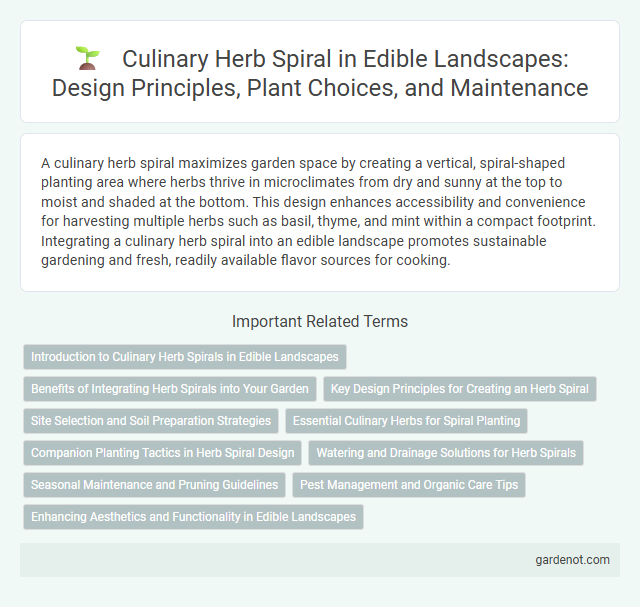A culinary herb spiral maximizes garden space by creating a vertical, spiral-shaped planting area where herbs thrive in microclimates from dry and sunny at the top to moist and shaded at the bottom. This design enhances accessibility and convenience for harvesting multiple herbs such as basil, thyme, and mint within a compact footprint. Integrating a culinary herb spiral into an edible landscape promotes sustainable gardening and fresh, readily available flavor sources for cooking.
Introduction to Culinary Herb Spirals in Edible Landscapes
Culinary herb spirals are space-efficient garden structures that maximize the growth of diverse herbs by creating microclimates along a vertical spiral design. These spirals support a variety of edible herbs such as basil, thyme, and rosemary, optimizing sunlight exposure, drainage, and soil conditions for each plant's needs. Incorporating culinary herb spirals into edible landscapes enhances both aesthetic appeal and functional usage, providing easy access to fresh herbs for cooking year-round.
Benefits of Integrating Herb Spirals into Your Garden
Integrating a culinary herb spiral into your garden maximizes space efficiency by allowing vertical growth, which supports a diverse range of herbs with varying water and sunlight needs. This design promotes biodiversity and pest control by attracting beneficial insects and repelling harmful ones naturally. Herb spirals also enhance garden aesthetics and provide easy access to fresh, nutrient-rich herbs for cooking throughout the growing season.
Key Design Principles for Creating an Herb Spiral
A culinary herb spiral maximizes vertical and horizontal growing space by layering herbs based on their water and sunlight needs, with drought-tolerant species like rosemary positioned at the top and moisture-loving herbs such as basil at the bottom. Incorporating a central composting core improves soil fertility, while designing a gentle slope ensures proper drainage and easy access to all herb varieties. Using locally sourced, nutrient-rich soil and arranging herbs according to microclimate zones enhances growth and harvest efficiency in edible landscapes.
Site Selection and Soil Preparation Strategies
Selecting a sunny, well-drained site with access to water is crucial for a successful culinary herb spiral, as most herbs require at least six hours of sunlight daily and consistent moisture. Soil preparation involves loosening the soil to a depth of 12-18 inches and incorporating organic matter such as compost or aged manure to improve fertility and drainage. Creating a slightly raised spiral bed enhances microclimates, encouraging diverse herb growth by optimizing temperature and moisture retention in different sections.
Essential Culinary Herbs for Spiral Planting
Essential culinary herbs for spiral planting include rosemary, thyme, basil, and oregano, all of which thrive in the well-drained, sun-exposed tiers of a culinary herb spiral. This design maximizes vertical space and microclimates, allowing herbs with varying water and sunlight needs to coexist efficiently. Incorporating mint at the base helps contain its invasive growth, maintaining the balance and productivity of the herb spiral.
Companion Planting Tactics in Herb Spiral Design
Culinary herb spirals maximize space by incorporating companion planting tactics, promoting natural pest control and enhanced growth through strategic plant placement. Herbs like basil, thyme, and oregano are positioned to repel pests and attract beneficial insects, improving overall herb vitality. Integrating complementary plants in the spiral structure fosters healthier microclimates and nutrient cycling within the edible landscape.
Watering and Drainage Solutions for Herb Spirals
Herb spirals require efficient watering and drainage systems to maintain optimal moisture levels for diverse culinary herbs with varying water needs. Incorporating a sloped design and porous soil mixtures, such as compost-rich loam and sand, helps prevent waterlogging and encourages healthy root growth. Installing drip irrigation or soaker hoses ensures consistent hydration while minimizing water waste and reducing the risk of fungal diseases in the edible landscape.
Seasonal Maintenance and Pruning Guidelines
Seasonal maintenance of a culinary herb spiral involves regular pruning to promote healthy growth and prevent overcrowding. Focus on trimming herbs like thyme, oregano, and rosemary during their active growing seasons to enhance flavor concentration and air circulation. Remove any dead or woody stems annually to rejuvenate plants and maintain the spiral's aesthetic and functional design.
Pest Management and Organic Care Tips
Culinary herb spirals enhance pest management through natural plant diversity, attracting beneficial insects like ladybugs and predatory wasps that suppress harmful pests. Organic care includes using neem oil or insecticidal soap for targeted treatments, along with companion planting techniques to deter aphids and spider mites. Maintaining healthy soil with compost and regular mulching boosts plant resilience and reduces disease incidence in edible landscapes.
Enhancing Aesthetics and Functionality in Edible Landscapes
A culinary herb spiral maximizes vertical space by creating a raised, spiral structure that accommodates a diverse range of herbs with varying sun and water needs, enhancing the overall functionality of edible landscapes. Its visually appealing design introduces dynamic height and texture, offering an attractive focal point in garden settings. The efficient layout not only simplifies harvesting but also promotes healthier plant growth through improved drainage and microclimates.
Culinary herb spiral Infographic

 gardenot.com
gardenot.com